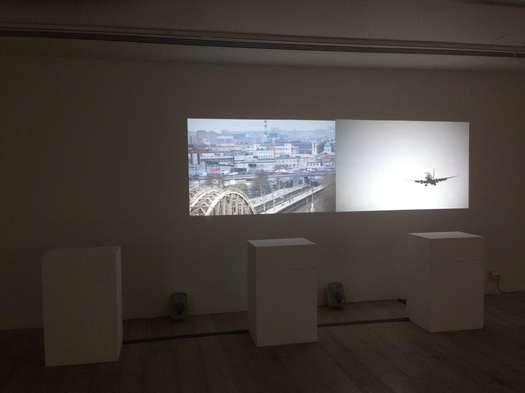Review: Burning News, Hayward Gallery
Above: Tim Parchikov, Burning News series, 2011 / Courtesy of Hayward Gallery
Five or six new articles, tweets and posts would appear on your newsfeed while you are reading this sentence. We are not able anymore to calmly go through just one newspaper in the morning to know what is happening in the world, as it was several decades ago. Burning News: Recent Art from Russia exhibition at Hayward Gallery showcases works created from 2011 – 2013 by young Russian artists in response to a changing perception of the everyday information stream. The show, curated by Olga Sviblova, Director of Moscow’s House of Photography and Multimedia Art Museums, for the UK-Russia Year of Culture 2014 includes videos by Evgeny Granilshchikov, Mikhail Maksimov, Sasha Pirogova and Dimitri Venkov, as well as sculpture by Aslan Gaisumov and photography by Tim Parchikov.
“News stopped being just hot, it’s burning,” says Olga Sviblova. Burning news series (2011) by Tim Parchikov presents a vivid illustration of this statement, showing how the news quickly looses urgency, even in the moment of reading. People in Parchikov’s photographs stand in snowy landscapes and read newspapers blazing in their hands. Displayed at the very beginning of the show, Burning News series invites visitors to rethink their approach to news consumption and look for alternative ways of dealing with the information overload.
Evgeny Granilshikov, for instance, in his video Positions (2013) decides to play with the structure of the film, juxtaposing monochrome and colour film, still-life scenes with traffic-flowing cityscapes. Breaking the ordinary structure of the narrative, Granilshikov designs a new one, creating a different story from the same pieces of information.

Evgeny Granilshikov, Positions, 2013 / Courtesy of Anna Prosvetova
Sasha Pirogova’s BIBLIMLEN (2013) and Aslan Gaisumov’s Untitled (War) series (2011; 2013) take more traditional sources of information and explore how their image has changed today. The renowned store of knowledge, the Russian State Library in Moscow, becomes a place for games, a zone of conflict and a dancing area in Pirogova’s BIBLIMLEN. Gaisumov also turns a traditional source of knowledge, a book, into something new and unexpected – a symbol of war and destruction. As a witness of the Chechen war the artist avoids using aggressive imagery or any dramatic representations of war, choosing instead mutilated books and their remains as silent victims, converting this source of information on the past into an embodiment of the history itself.

Sasha Pirogova, BIBLIMLEN, 2013 / Courtesy of www.mamm-mdf.ru
So what should people do today, when the information is changing rapidly and the news is often controversial and ambiguous? Some artists suggest a solution – to create your own news, your own stories, like in Dmitry Venkov’s Mad Mimes video (2012). Using all the traditional features of a documentary, this video presents an anthropological study of a tribe living along Moscow’s Ring Road. However, on closer examination it turns out to be a mockumentary with actors performing roles such as on-screen experts and members of a fictitious tribe. Mimicking the source of real information, this video poses an important question about reliability of news and experts’ opinions today.

Mikhail Maksimov, Barriers, 2011 / Courtesy of Courtesy of Anna Prosvetova
In Barriers (2011) Mikhail Maksimov creates an ordinary backdrop, detached from viewers by digitally generated barriers. The artist calls every visitor to participate in the breaking of these constructed obstacles between viewers and the environment, simply using their hands and Russian birches. Symbolising the state control over the media, the virtual metal fences appear to be not as solid under direct action of the audience.
Russia has been a frequent subject of news during the recent five years and the show at Hayward Gallery reveals how the young artists react to the quantity and diversity of information on their homeland, trying to distinguish the reality from fiction.
For more information on the exhibition: www.russianartandculture.com/exh-burning-news
The review was originally published on Russian Art and Culture